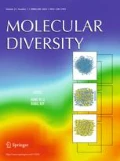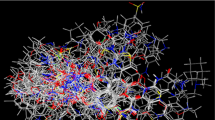Abstract
Multi-target directed ligand-based 2D-QSAR models were developed using different N-benzyl piperidine derivatives showing inhibitory activity toward acetylcholinesterase (AChE) and β-Site amyloid precursor protein cleaving enzyme (BACE1). Five different classes of molecular descriptors belonging to spatial, structural, thermodynamics, electro-topological and E-state indices were used for machine learning by linear method, genetic function approximation (GFA) and nonlinear method, support vector machine (SVM) and artificial neural network (ANN). Dataset used for QSAR model development includes 57 AChE and 53 BACE1 inhibitors. Statistically significant models were developed for AChE (R2 = 0.8688, q2 = 0.8600) and BACE1 (R2 = 0.8177, q2 = 0.7888) enzyme inhibitors. Each model was generated with an optimum five significant molecular descriptors such as electro-topological (ES_Count_aaCH and ES_Count_dssC), structural (QED_HBD, Num_TerminalRotomers), spatial (JURS_FNSA_1) for AChE and structural (Cl_Count, Num_Terminal Rotomers), electro-topological (ES_Count_dO), electronic (Dipole_Z) and spatial (Shadow_nu) for BACE1 enzyme, determining the key role in its enzyme inhibitory activity. The predictive ability of the generated machine learning models was validated using the leave-one-out, Fischer (F) statistics and predictions based on the test set of 11 AChE (r2 = 0.8469, r2pred = 0.8138) and BACE1 (r2 = 0.7805, r2pred = 0.7128) inhibitors. Further, nonlinear machine learning methods such as ANN and SVM predicted better than the linear method GFA. These molecular descriptors are very important in describing the inhibitory activity of AChE and BACE1 enzymes and should be used further for the rational design of multi-targeted anti-Alzheimer’s lead molecules.
Graphic abstract







Similar content being viewed by others
References
Hou Y, Dan X, Babbar M, Wei Y, Hasselbalch SG, Croteau DL, Bohr VA (2019) Ageing as a risk factor for neurodegenerative disease. Nat Reviews Neurol 15(10):565–581. https://doi.org/10.1038/s41582-019-0244-7
Wenk GL (2003) Neuropathologic changes in Alzheimer’s disease. J Clini Psychia 64(suppl 9):7–10 (PMID: 12934968)
Mattson MP (2004) Pathways towards and away from Alzheimer’s disease. Nature 430(7000):631–639. https://doi.org/10.1038/nature02621
Schelterns P, Feldman H (2003) Treatment of Alzheimer’s disease; current status and new perspectives. Lanc Neurol 2(9):539–547. https://doi.org/10.1016/s1474-4422(03)00502-7
Briggs R, Kennelly SP, O’Neill D (2016) Drug treatments in Alzheimer’s disease. Clini Med 16(3):247. https://doi.org/10.7861/clinmedicine.16-3-247
Conrado DJ, Duvvuri S, Geerts H, Burton J, Biesdorf C, Ahamadi M, Macha S, Hather G, Francisco Morales J, Podichetty J, Nicholas T, Stephenson D, Trame M, Romero K, Corrigan B (2020) Drug development tools in the alzheimer disease continuum (ddt-ad) working group. challenges in Alzheimer's Disease drug discovery and development: the role of modeling, simulation, and open data. Clin Pharmacol Ther 107(4):796–805. doi: https://doi.org/10.1002/cpt.1782.
Cacabelos R (2018) Have there been improvements in Alzheimer’s disease drug discovery over the past 5 years? Expert Opin Drug Discov 13(6):523–538. https://doi.org/10.1080/17460441.2018.1457645
Cheung J, Rudolph MJ, Burshteyn F, Cassidy MS, Gary EN, Love J, Franklin MC, Height JJ (2012) Structures of human acetylcholinesterase in complex with pharmacologically important ligands. J Med Chem 55(22):10282–10286. https://doi.org/10.1021/jm300871x
Tran TS, Tran TD, Tran TH, Mai TT, Nguyen NL, Thai KM, Le MT (2020) Synthesis, In silico and in vitro evaluation of some flavone derivatives for acetylcholinesterase and BACE-1 inhibitory activity. Molecules 25(18):4064. https://doi.org/10.3390/molecules25184064
Huang W, Tang L, Shi Y, Huang S, Xu L, Sheng R, Wu P, Li J, Zhou N, Hu Y (2011) Searching for the multi-target-directed ligands against Alzheimer’s disease: discovery of quinoxaline-based hybrid compounds with AChE, H3R and BACE 1 inhibitory activities. Bioorg Med Chem 19(23):7158–7167. https://doi.org/10.1016/j.bmc.2011.09.061
Dvir H, Silman I, Harel M, Rosenberry TL, Sussman JL (2010) Acetylcholinesterase: from 3D structure to function. Chemico-Biol Interact 187(1–3):10–22. https://doi.org/10.1016/j.cbi.2010.01.042
Sharma P, Tripathi A, Tripathi PN, Prajapati SK, Seth A, Tripathi MK, Srivastava P, Tiwari V, Krishnamurthy S, Shrivastava SK (2019) Design and development of multitarget-directed N-Benzylpiperidine analogs as potential candidates for the treatment of Alzheimer’s disease. Europ J Med Chem 167:510–524. https://doi.org/10.1016/j.ejmech.2019.02.030
Sharma P, Tripathi A, Tripathi PN, Singh SS, Singh SP, Shrivastava SK (2019) Novel molecular hybrids of n-benzylpiperidine and 1, 3, 4-oxadiazole as multitargeted therapeutics to treat alzheimer’s disease. ACS Chem Neurosci 10(10):4361–4384. https://doi.org/10.1021/acschemneuro.9b00430
Andersson CD, Hillgren JM, Lindgren C et al (2015) Benefits of statistical molecular design, covariance analysis, and reference models in QSAR: a case study on acetylcholinesterase. J Comput Aided Mol Des 29:199–215. https://doi.org/10.1007/s10822-014-9808-1
Bahuguna A, Bharatam PV, Rawat DS (2021) 3D QSAR studies on amphiphilic indoles for antimycobacterial activity. J Biochem Mol Toxicol 35(3):e22675. https://doi.org/10.1002/jbt.22675
Roy K, Mitra I (2012) Electrotopological state atom (E-state) index in drug design, QSAR, property prediction and toxicity assessment. Curr Comput Aided Drug Des 8(2):135–158. https://doi.org/10.2174/157340912800492366
Ponzoni I, Sebastián-Pérez V, Martínez MJ et al (2019) QSAR Classification models for predicting the activity of inhibitors of beta-secretase (BACE1) associated with Alzheimer’s disease. Sci Rep 9:9102. https://doi.org/10.1038/s41598-019-45522-3
Kumar V, Saha A, Roy K (2020) In silico modeling for dual inhibition of acetylcholinesterase (AChE) and butyrylcholinesterase (BuChE) enzymes in Alzheimer’s disease. Comput Biol Chem 88:107355. https://doi.org/10.1016/j.compbiolchem.2020.107355
Roy KK, Dixit A, Saxena AK (2008) An investigation of structurally diverse carbamates for acetylcholinesterase (AChE) inhibition using 3D-QSAR analysis. J Mol Graph Model 27(2):197–208. https://doi.org/10.1016/j.jmgm.2008.04.006
Wong KY, Mercader AG, Saavedra LM et al (2014) QSAR analysis on tacrine-related acetylcholinesterase inhibitors. J Biomed Sci 21:84. https://doi.org/10.1186/s12929-014-0084-0
Anju CP, Subhramanian S, Sizochenko N, Melge AR, Leszczynski J, Mohan CG (2019) Multiple e-Pharmacophore modeling to identify a single molecule that could target both streptomycin and paromomycin binding sites for 30S ribosomal subunit inhibition. J Biomol Struct Dyn 37(6):1582–1596. https://doi.org/10.1080/07391102.2018.1462731
Mungalpara J, Pandey A, Jain V, Mohan CG (2010) Molecular modelling and QSAR analysis of some structurally diverse N-type calcium channel blockers. J Mol Model 16(4):629–644. https://doi.org/10.1007/s00894-009-0591-1
Pandey A, Mungalpara J, Mohan CG (2010) Comparative molecular field analysis and comparative molecular similarity indices analysis of hydroxyethylamine derivatives as selective human BACE-1 inhibitor. Mol Divers 14(1):39–49. https://doi.org/10.1007/s11030-009-9139-7
Cherkasov A, Muratov EN, Fourches D, Varnek A, Baskin II, Cronin M, Dearden J, Gramatica P, Martin YC, Todeschini R (2014) QSAR modeling: Where have you been? Where are you going to? J Med Chem 57(12):4977–5010. https://doi.org/10.1021/jm4004285
Shahlaei M (2013) Descriptor selection methods in quantitative structure–activity relationship studies: a review study. Chem Rev 113(10):8093–8103. https://doi.org/10.1021/jm4004285
Gupta S, Fallarero A, Järvinen P, Karlsson D, Johnson MS, Vuorela PM, Mohan CG (2011) Discovery of dual binding site acetylcholinesterase inhibitors identified by pharmacophore modeling and sequential virtual screening techniques. Bioorg Med Chem Lett 21(4):1105–1112. https://doi.org/10.1016/j.bmcl.2010.12.131
Shailesh KP, Indira G (2019) In silico structure based prediction of Receptor-ligand binding ainity. Current progress and challenges, In: Mohan CG (ed) Structural Bioinformatics: applications in preclinical drug discovery process, 1st edn, Springer Nature (USA), pp 109–175
Carpenter KA, Huang X (2018) Machine learning-based virtual screening and its applications to Alzheimer’s drug discovery: a review. Curr Pharm Des 24(28):3347–3358. https://doi.org/10.2174/1381612824666180607124038
Mishra R, Li B (2020) The application of artificial intelligence in the genetic study of Alzheimer’s disease. Aging Dis 11(6):1567–1584. https://doi.org/10.14336/AD.2020.0312
Yang X, Wang Y, Byrne R, Schneider G, Yang S (2019) Concepts of artificial intelligence for computer-assisted drug discovery. Chem Rev 119(18):10520–10594. https://doi.org/10.1021/acs.chemrev.8b00728
Lavecchia A (2015) Machine-learning approaches in drug discovery: methods and applications. Drug Discov Today 20(3):318–331. https://doi.org/10.1016/j.drudis.2014.10.012
ChemBio3D Ultra software ver. 14.0 (2014) PerkinElmer, Inc. ChemBioOffice
BIOVIA DS, (2018) BIOVIA Discovery studio. Dassault systems, San Diego
Friedman JH (2001) Greedy function approximation: a gradient boosting machine. Ann Stat 29(5):1189–1232
WEKA software, Ver. 3.8.4 (2020)
Cortes C, Vapnik V (1995) Support-vector networks. Machine Learn 20(3):273–297. https://doi.org/10.1007/BF00994018
Roy K, Kar S (2014) The rm2 metrics and regression through origin approach: Reliable and useful validation tools for predictive QSAR models (Commentary on “Is regression through origin useful in external validation of QSAR models?”). Europ J Pharm Sci 62:111–114
Tropsha A, Golbraikh A (2007) Predictive QSAR modeling workflow, model applicability domains, and virtual screening. Curr Pharma Design 13(34):3494–3504
Gupta S, Fallarero A, Vainio MJ, Saravanan P, Santeri Puranen J, Järvinen P, Johnson MS, Vuorela PM, Mohan CG (2011) Molecular docking guided comparative GFA, G/PLS, SVM and ANN models of structurally diverse dual binding site acetylcholinesterase inhibitors. Mol Inform 30(8):689–706. https://doi.org/10.1002/minf.201100029
Recanatini M, Cavalli A, Hansch C (1997) A comparative QSAR analysis of acetylcholinesterase inhibitors currently studied for the treatment of Alzheimer’s disease. Chem Biol Interact 105(3):199–228. https://doi.org/10.1016/s0009-2797(97)00047-1
Mungalpara J, Pandey A, Jain V, Mohan CG (2010) Molecular modeling and QSAR analysis on some structurally diverse N-type calcium channel blockers. J Mol Model 16(4):629–644. https://doi.org/10.1007/s00894-009-0591-1
Pandey A, Jignesh M, Mohan CG (2010) Comparative molecular field analysis and comparative molecular similarity indices analysis of hydroxyethylamine derivatives as selective human BACE-1 inhibitor. Mol Divers 14(1):39–49. https://doi.org/10.1007/s11030-009-9139-7
Awale M, Mohan CG (2008) 3D QSAR CoMFA analysis of C5 substituted Pyrrolotriazines as HER2 (ErbB2) inhibitors. J Mol Graphics Model 26(7):1169–1178. https://doi.org/10.1016/j.jmgm.2007.10.008
Niu B, Zhao M, Su Q, Zhang M, Lv W, Chen Q, Chen F, Chu D, Du D, Zhang Y (2017) 2D-SAR and 3D-QSAR analyses for acetylcholinesterase inhibitors. Mol Divers 21(2):413–426. https://doi.org/10.1007/s11030-017-9732-0
Acknowledgements
The authors acknowledge Computational biology and Bioinformatics Lab, Centre for Nanosciences and Molecular Medicine, Amrita Vishwa Vidyapeetham, Kochi, for the computing infrastructure support. CGM gratefully acknowledges the Department of Biotechnology (DBT), India, for providing financial support in procuring the Discovery studio license used in the present study (Grant No. BT/PR21018/BID/7/776/2016).
Author information
Authors and Affiliations
Corresponding author
Ethics declarations
Conflict of interest
Authors declare no competing interests.
Additional information
Publisher's Note
Springer Nature remains neutral with regard to jurisdictional claims in published maps and institutional affiliations.
Supplementary Information
Below is the link to the electronic supplementary material.
Rights and permissions
About this article
Cite this article
Dhamodharan, G., Mohan, C.G. Machine learning models for predicting the activity of AChE and BACE1 dual inhibitors for the treatment of Alzheimer’s disease. Mol Divers 26, 1501–1517 (2022). https://doi.org/10.1007/s11030-021-10282-8
Received:
Accepted:
Published:
Issue Date:
DOI: https://doi.org/10.1007/s11030-021-10282-8




